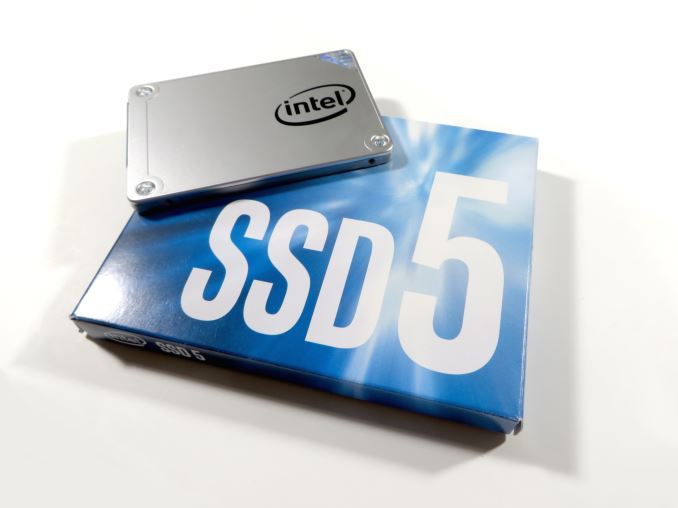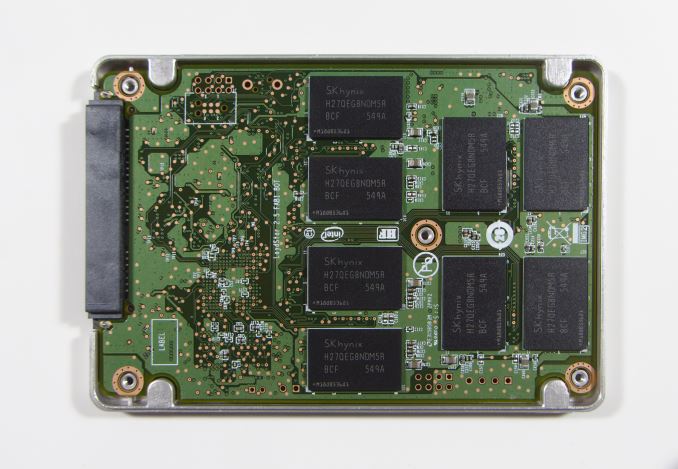The Intel SSD 540s (480GB) Review
by Billy Tallis on June 23, 2016 9:00 AM EST
Every few years, Intel releases a new SSD controller that raises the bar for the whole industry. In between those shake-ups, the competition catches up and surpasses Intel. This pattern is especially pronounced in the consumer SSD market where Intel's mostly enterprise-focused chips cannot keep pace with the constant price cuts. During those interim years Intel turns to third-party controllers to fill the gaps in the product line that their own controllers cannot serve.
This year, Intel's decision to release an affordable mainstream SATA SSD has led them to use a Silicon Motion controller. But "affordable" by today's standards means using 15/16nm TLC NAND flash, and Intel doesn't make that either. They chose not to invest in the 16nm node at IMFT (their flash manufacturing partnership with Micron) so Intel has to buy their flash on the open market.
The result is the Intel 540s, using Silicon Motion's new SM2258 controller and SK Hynix 16nm TLC NAND. The SM2258 controller is the successor to the SM2256, Silicon Motion's first controller designed for use with TLC flash. SM2258 builds on that design by moving from 55nm fabrication to 40nm and incorporating several hardware tweaks including more flexible SLC caching and support for 3D NAND.
The Hynix TLC used in the Intel 540s is the same NAND that is inside the ADATA Premier SP550, one of two products we've tested that use the SM2256 controller. This gives us the opportunity to directly observe what's improved with Silicon Motion's controller and firmware since last year. The price history of the ADATA SP550 also shows that Intel should be able to make the 540s a very affordable product. It also appears that Intel has retired the use of 3xx model numbers to designate entry-level SSDs and all such models are now classified as legacy products.
| Intel SSD 540s Specifications | ||||||
| Capacity | 120GB | 180GB | 240GB | 360GB | 480GB | 1000GB |
| Controller | Silicon Motion SM2258 | |||||
| NAND Flash | SK Hynix 16nm TLC | |||||
| Sequential Read | 560MB/s | |||||
| Sequential Write | 400MB/s | 475MB/s | 480MB/s | |||
| Random Read IOPS | 60k | 71k | 74k | 78k | ||
| Random Write IOPS | 50k | 85k | ||||
| TCG Opal Encryption | No | |||||
| Power Management | Slumber and DevSleep | |||||
| Form Factor | 2.5" 7mm and M.2 2280 | |||||
| Warranty | 5 years | |||||
| Recommended Customer Price | $64 | $79 | $99 | $139 | $174 | $344 |
The 540s has Intel's typical aluminum casing housing a full-size PCB. Our 480GB sample had 16 packages each with two dies of the SK Hynix TLC. The new SM2258 controller uses the same 14mm x 14mm package as the SM2256, with a single external DRAM package next to it. As is typical for low-cost consumer drives, there are no power loss protection capacitors. There is a thermal pad between the controller and the case, something we saw for the SM2256 on the Crucial BX200 but not the ADATA SP550.
The PCB also bears the "Loyd Star" codename which the 540s shares with Intel's SSD E 5400s for the embedded market and the SSD DC S3100 for the enterprise market. The E 5400s covers only small capacities, ranging from 48GB to 180GB while the 540s is available in capacities from 120GB to 1000GB and the DC S3100 covers 180GB to 1000GB. All three product lines include some in-between sizes that are uncommon to find on modern drives. The 540s and E5400s are both available as 2.5" or M.2 drives while the DC S3100 is only available as a 2.5" drive.
For this review, the Intel 540s will primarily be compared against the two SM2256 products we've tested: the ADATA Premier SP550 and the Crucial BX200. The latter shipped with poorly-tuned firmware that made it a disappointment all around, but the former has been a relatively successful budget drive by offering acceptable performance at some of the best prices on the market. The Intel 540s is positioned slightly higher in the market due to carrying a 5-year warranty compared to three years for most budget TLC drives, but in terms of performance that's what it is competing against.
Other important drives to compare against will include the Toshiba OCZ Trion 150, a higher-performing drive using a controller based on the Phison S10 paired with Toshiba 15nm TLC, and the SanDisk X400 using Marvell's 88SS1074 controller and SanDisk's 15nm TLC. The SanDisk X400 seems to be the fastest planar TLC drive on the market, and it is available in both 2.5" and single-sided M.2 form factors. The SanDisk X400 also has a 5-year warranty.
| AnandTech 2015 SSD Test System | |
| CPU | Intel Core i7-4770K running at 3.5GHz (Turbo & EIST enabled, C-states disabled) |
| Motherboard | ASUS Z97 Pro (BIOS 2701) |
| Chipset | Intel Z97 |
| Memory | Corsair Vengeance DDR3-1866 2x8GB (9-10-9-27 2T) |
| Graphics | Intel HD Graphics 4600 |
| Desktop Resolution | 1920 x 1200 |
| OS | Windows 8.1 x64 |
- Thanks to Intel for the Core i7-4770K CPU
- Thanks to ASUS for the Z97 Deluxe motherboard
- Thanks to Corsair for the Vengeance 16GB DDR3-1866 DRAM kit, RM750 power supply, Carbide 200R case, and Hydro H60 CPU cooler












77 Comments
View All Comments
Ananke - Thursday, June 23, 2016 - link
It is not the brand image, Intel is a government registered contractor, and it is US company, i.e. its products would be prioritized before price concerns.catavalon21 - Thursday, June 23, 2016 - link
Most USG computers are purchased all-up OEM systems (Dell, IBM, HP, etc.), and inclusion of a "foreign" SSD or HDD wouldn't slow down the purchase for a minute.Gigaplex - Thursday, June 23, 2016 - link
This barely qualifies as an Intel product. Other than firmware they didn't really build any of this.Vorl - Thursday, June 23, 2016 - link
So, you are defending overpriced crap because it's for government/corporate use? Wouldn't those same entities be better served with either cheaper similar performing options, or same priced better performing options?Honestly, you seem like you are defending them pretty hard and not using logic.
JoeyJoJo123 - Thursday, June 23, 2016 - link
I'm not defending it.Intel's milking their brand name, and more power to them. There isn't anything exactly evil for marking up your products because you have a global brand name (see: Apple, IBM, Beats, Bose, etc.)
Educated consumers like me and you are wiser than to buy this.
That being said, just because a smart consumer (again, you or I) shouldn't buy it, doesn't mean there's no point in releasing this SSD to the market. Let the sheeple buy them, you nor I should care about their choices in expenditures.
BurntMyBacon - Friday, June 24, 2016 - link
@JoeyJoJo123: "Let the sheeple buy them, you nor I should care about their choices in expenditures."Ideally no, we shouldn't. After all, if companies can make more money off of the "sheeple", then informed consumers can often times get a better value on another product that should by all rights be selling more if not for the "sheeple". However, letting the "sheeple" buy overpriced products from companies with a solid product line will sometimes encourage the company to overprice other products that informed consumers may have interest in. It's not always good for the informed consumer to leave the "sheeple" uninformed. Just don't get emotionally invested as it will almost certainly cause the opposite of the desired outcome.
vladx - Friday, June 24, 2016 - link
Indeed we should do our best and inform average joes about this kind of stuff whenever we can. This wat, more good products will be pushed instead of "trash" like this Intel SSD.catavalon21 - Thursday, June 23, 2016 - link
Fair enough on the corp / gov end use, though I have to wonder...who are they targeting with the 5 year warranty?euskalzabe - Friday, June 24, 2016 - link
Wait... how can you say that governments want to buy from "reputable" brands but then say that "brand image" doesn't count? If there's bad brand image, there's no reputation to talk about. They're essentially connected.JoeyJoJo123 - Monday, June 27, 2016 - link
Let me explain:Governments will make bulk purchases of resources they supposedly need. At one point the government purchases thousands of PS3s to network into a computing cluster. When the Pentium 4 came out, thousands of Pentium 4 computers were purchased by the government for government usage. Government entities seem to make these purchases primarily by brand recognition. Government entities rarely (if ever) purchase cheap Chinese PCs for official government usage, even though it would probably save them a lot of dough rather than procuring bulk workstations from HP/Dell/Lenovo, etc. Intel's a brand name and it's entirely feasibly that a Government IT sector office would procure bulk Intel SSDs to retrofit into slow/problematic workstations to prolong that workstation's lifespan, rather than purchase an entirely new workstation for that user.
On a personal level:
Never buy on brand name alone. Not every product a brand makes is great, and you shouldn't let good products that a company has made in the past cloud your judgment or decision on any particular other product. Unfortunately, Government procurements don't seem to follow this rationale.